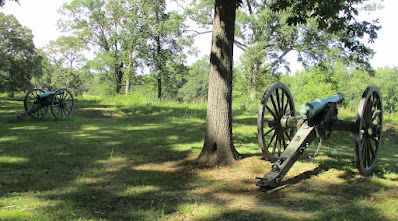After visiting the "Sunken Road" area of Fredericksburg, Virginia, I proceeded to what could be called the "rural" portion of the Fredericksburg battlefield. After I started driving down Lee Drive, I stopped at Confederate General Robert E. Lee's headquarters, known today as Lee Hill. From the road, I had to take a hike uphill, which was fortunately rather short. At the top of the hill are these two cannons, of different sizes.
The area also includes a shelter, a few informational plaques, and a structure made of three concrete slabs, which are offset from each other.
The top concrete slab includes markers that point to Washington, D.C. and Fredericksburg (the two at the left) and to Richmond, Virginia (the one at the right).
Just south of Lee's Hill is Howison Hill, named after a local family. Confederate forces used this hill to place some of their artillery. Today, two cannons of different sizes are located just off Lee Drive. If you visit this spot, please do not climb on the cannons.
I eventually arrived at the end of Lee Drive in an area called Prospect Hill. I then hiked on a trail that leads to an area called Hamilton's Crossing, which was a supply base for Confederate troops. This place has no monuments, cannons, or anything else that I would consider photogenic, so I took a photo of the trail as I returned to Prospect Hill.
Prospect Hill has these two cannons.
It also has these other two cannons.
After I left Prospect Hill, I found a small parking area from which I could see Meade's Pyramid. Although bearing the name of Union General George Meade, it was built by the Confederate Memorial Literary Society. I couldn't find any trail that might have led me closer to the pyramid, which was also on the other side of railroad tracks, but I was still able to get a decent shot of it.
My last stop in the Fredericksburg battlefield was another hike, this time to the site of the Bernard slave cabins. Before the Civil War, the site was home to about 35 slaves and included three cabins, a well, and possibly two other buildings. The people, land, and structures all belonged to Arthur Bernard, whose 1,800-acre plantation was known as Mannsfield. Confederate forces used the area as an artillery position. Today, it has two informational plaques, one of which is shown in this last photo.
Thus concludes my travelogue of four Civil War battlefields near Fredericksburg, Virginia. See youz soon.









No comments:
Post a Comment